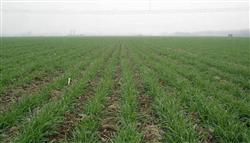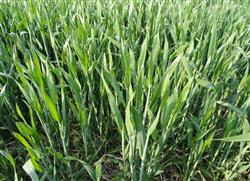How to Control Diseases and insect pests in Wheat Seedling stage

How to control diseases and insect pests in wheat seedling stage? Please guide that in general, about 15 days after wheat sowing, the wheat seedlings will basically grow, so in the future, how to manage and protect the wheat seedlings is very critical. The author recommends several methods to control wheat seedling diseases and insect pests. 15-20 days after the emergence of wheat rust, wheat fields with disease conditions were selected for investigation. When the rate of diseased leaves reached 10%, and the temperature was too high in autumn and Rain Water was on the high side, the wheat rust was immediately sprayed with triadimefon or triadimefon, that is, 12.5% WP 1520 g or 15% Triadimefon WP 75 g per mu was used to spray 50 kg of water. One piece at a time. Wheat sheath blight can occur from seedling stage to heading stage. The symptoms of the seedling stage are mainly manifested in the underground part, which harms the underground stem of wheat after emergence, showing brown or oval spots, and developing upward. 75 grams of 20% vermicellin wettable powder or 40 grams of 20% Jinggangmycin per mu can be sprayed 50 kg of water along the ridge. The pathogen of wheat take-all disease could be infected in the wheat seedling stage, and the infection peak was 20-30 days after emergence. For the plots where total erosive disease of wheat has occurred in the past, spraying seedlings with 12.5% Heguoli wettable powder 15g / mu or 20% EC 120g / mu to 40kg / mu to 40kg / mu can significantly reduce the incidence of wheat at spike stage. Wheat aphid can not only directly damage the yield of wheat, but also spread wheat yellow dwarf disease. When the rate of aphids is more than 5% and the number of aphids per hundred plants is about 10, chemical control should be carried out. Use 25ml of aphid lice net per mu or 20g of imidacloprid or 20g of imidacloprid to water 40kg and 50kg, spray along the ridge, and can also control wheat red spiders. The main underground pests harming wheat at seedling stage are mole cricket, grub and golden needle worm. It is observed that when the mole cricket is harmful, the tender stem of the wheat seedling will be bitten into a random hemp shape, and the fracture surface is irregular; when the grub is harmful, the root and stem of the wheat seedling will be bitten off and the fracture surface is neat; the golden needle worm drills into the tender heart of the wheat stem, and the injured part is hemp-like, but the outer skin is still linked together. By carefully observing the damage of wheat seedlings, we can determine which kind of underground pest appeared in the wheat field. Representative plots were selected for investigation 30 days after wheat emergence, and pesticide control was carried out immediately when the seedling death rate reached 3%. Wear trichlorfon poison cake: use 90% crystal trichlorfon 75 grams per mu, first melt it with warm water, then add water to 1.5 kg to form a medicine solution, spray and mix on 10 kg of crushed sesame cake or rapeseed cake, stuffy for 4 hours for 6 hours, then become poison cake. Put the poison bait on the wheat field with bait. The effect of killing insects and protecting seedlings by this method can reach 95%. Spread poisonous soil: use 2% methyl isophosphates powder 2 kg per mu to mix fine soil 30 kg 40 kg, mix well and then ditch it into the wheat ridge, which can effectively prevent the harm of grubs and golden needles. Sprinkler irrigation potion: for plots where spot damage occurs, 40% methyl isophos or 50% phoxim 0.5 kg per mu can be used for 60 kg / mu of water, spraying wheat roots along ridges, which has a special effect on grubs and golden needle worms. Locusts and crickets have occurred in large quantities in recent years, often endangering early-sowing wheat seedlings. 75 grams of 90% crystal trichlorfon can be used per mu, first with hot hydration and then add water to 1.5 kilograms, spray and mix 5 kilograms of fried wheat bran into poison bait, spread traps along the ridge, and the effect is very good. Click to get more wheat planting technology click to get more grain planting technology
- Prev

What are the diseases and insect pests of wheat at seedling stage
What are the diseases and insect pests in wheat seedling stage? Please introduce the wheat rust 15-20 days after emergence, select the wheat field with disease conditions for investigation, when the diseased leaf rate reaches 10%, and the autumn temperature is too high, Rain Water is on the high side, immediately spray triadimefon or triadimefon for control, that is, 12.5% WP per mu.
- Next

Which diseases and insect pests should be paid attention to during the filling stage of wheat?
Which diseases and insect pests should be paid attention to during the filling period of wheat? Please introduce that during the Beginning of Summer's period, the northern winter wheat generally entered the flowering and filling stage, and the demand for water was relatively large. Due to the high humidity in the field, wheat aphids, stripe rust and other diseases and insect pests further developed and spread. So in the near future, all parts of the northern winter wheat region still need.
Related
- The first cup of black tea in spring, the flavor and history of tea gardens in Kenya, Africa
- The computer can not only choose potatoes, but also grow tea rice. AI will grow winter oolong tea champion.
- It is not only the inflated tea bitten by insects, but also engraved with the four seasons tea in Beipu.
- The Oriental Beauty Tea Festival in Zhuxian County takes the stage at the weekend to experience the plus-size feast of oil tea.
- & quot; Oriental Beauty Tea & Exploration of Emei in Hsinchu, the hometown of quot;
- The new variety of strawberry "Tainong 1" dessert is the first choice with mellow aroma. Crimson gorgeous
- History of Tea in Taiwan: from Wild Inner Mountain to Export Tea Garden
- Two types of Taiwan Oriental Beauty Black Tea won the British three-Star Award for Childhood Tea Xiang Zhang Jiaqi changed from pilot to champion tea maker.
- Banana species and varieties: the planting history of Taiwan Xianren banana and dwarf banana is long, is banana disease resistant?
- Coffee planting Technology: Qianjie Coffee from Seedling to harvesting

